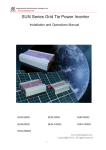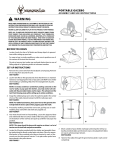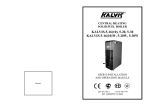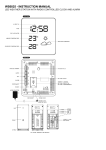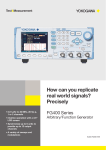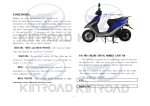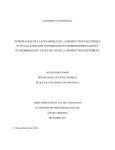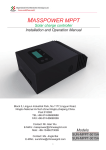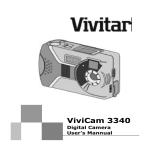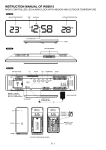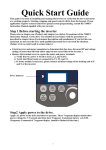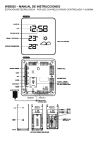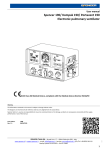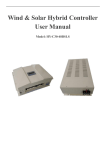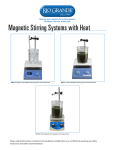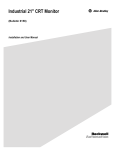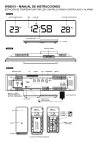Download User Manual for SUN Grid Tie Inverter_Wind_no_waterprint
Transcript
SUN Series Grid Tie Power Inverter (For Wind Turbines) Installation and Operations Manual SUN-250G SUN-300G SUN-500G SUN-600G SUN-1000G SUN-1500G SUN-2000G www.chinesegrid.com Copy Right 2014, All rights reserved 1 Table of Contents Sunshine Grid Tie Inverter Models ----------------------------------------------------------------------------------3 Model Name Description -------------------------------------------------------------------------------------4 Important Safety Information-------------------------------------------------------------------------------------------4 Safety Instruction-----------------------------------------------------------------------------------------------------------5 Instruction of Sunshine Grid Tie Inverter For Wind Turbine ----------------------------------------------------6 Sunshine Grid Tie Inverter Installation ------------------------------------------------------------------------------7 Installation Procedure ---------------------------------------------------------------------------------------------------8 Step 1 Considering the Total Capacity of the grid tie power system that you need-----------8 Step 2 Choosing Applicable Wind Turbines for Sunshine Grid Tie Inverter ------------------9 Step 3 Selecting Accessory for Grid Tie Power System installation------------------------------10 Step 4 Selecting Correct Model of Sunshine Grid Tie Inverter-------------------------------------11 Step 5 - Installing Wind Turbine to suitable place------------------------------------------------------13 Step 6 - Installing Sunshine Grid Tie Inverter to suitable place -----------------------------------13 Step 7 - Connecting Sunshine Grid Tie Power System with Cables and Connectors--------13 Step 8 – Grounding the system -----------------------------------------------------------------------------13 Step 9 – Connecting the PV modules after complete from Step1 to Step8---------------------13 Example of Installation of 1KW Grid Tie Power System ------------------------------------------------------13 The connection drawing of "SGWT"----------------------------------------------------------------------------------16 Installing Sunshine Grid Tie Power System to Three Phases Utility Grid-----------------------------------18 Layout of Sunshine Grid Tie Power Inverter ----------------------------------------------------------------------19 Technical Date of SUN Series Grid Tie Power Inverter----------------------------------------------------------22 Outline Drawing of SUN Series Grid Tie Power Inverter--------------------------------------------------------23 Weight and Dimension of SUN Series Grid Tie Power Inverter-----------------------------------------------25 2 Sunshine Grid Tie Inverter Models Sunshine grid tie inverters for wind trubines include a series of models, refer to table 1 and Table 2. For more information of all models, refer to the Sunshine website (http://www.chinesegrid.com). Table 1, Sunshine Grid Tie Inverter Models Model Number Rated Power (Peak/Continuous) DC Input Voltage AC Output AC Output Peak Inverter Night Voltage Range Frequency Range Efficiency Power Consumption SUN-250G-WDL-L-U 250W / 225W 10.8V~30V 90V~140V 46Hz~65Hz 90% 0.1W SUN-250G-WDL-M-U 250W / 225W 22V~60V 90V~140V 46Hz~65Hz 91% 0.1W SUN-250G-WDL-L-E 250W / 225W 10.8V~30V 190V~260V 46Hz~65Hz 90% 0.1W SUN-250G-WDL-M-E 250W / 225W 22V~60V 190V~260V 46Hz~65Hz 91% 0.1W SUN-300G-WDL-L-U 300W / 270W 10.8V~30V 90V~140V 46Hz~65Hz 90% 0.1W SUN-300G-WDL-M-U 300W / 270W 22V~60V 90V~140V 46Hz~65Hz 91% 0.1W SUN-300G-WDL-L-E 300W / 270W 10.8V~30V 190V~260V 46Hz~65Hz 90% 0.1W SUN-300G-WDL-M-E 300W / 270W 22V~60V 190V~260V 46Hz~65Hz 91% 0.1W SUN-500G-WDL-L-U 500W / 450W 10.8V~30V 90V~140V 46Hz~65Hz 90% 0.2W SUN-500G-WDL-M-U 500W / 450W 22V~60V 90V~140V 46Hz~65Hz 91% 0.2W SUN-500G-WDL-L-E 500W / 450W 10.8V~30V 190V~260V 46Hz~65Hz 90% 0.2W SUN-500G-WDL-M-E 500W / 450W 22V~60V 190V~260V 46Hz~65Hz 91% 0.2W SUN-600G-WDL-L-U 600W / 540W 10.8V~30V 90V~140V 46Hz~65Hz 90% 0.2W SUN-600G-WDL-M-U 600W /540W 22V~60V 90V~140V 46Hz~65Hz 91% 0.2W SUN-600G-WDL-L-E 600W / 540W 10.8V~30V 190V~260V 46Hz~65Hz 90% 0.2W SUN-600G-WDL-M-E 600W /540W 22V~60V 190V~260V 46Hz~65Hz 91% 0.2W SUN-1000G-WDL-M-U 1000W / 900W 22V~60V 90V~140V 46Hz~65Hz 90% 0.5W SUN-1000G-WDL-H-U 1000W / 900W 45V~90V 90V~140V 46Hz~65Hz 92% 1.5W SUN-1000G-WDL-M-E 1000W / 900W 22V~60V 190V~260V 46Hz~65Hz 90% 0.5W SUN-1000G-WDL-H-E 1000W / 900W 45V~90V 190V~260V 46Hz~65Hz 92% 1.5W SUN-1500G-WDL-H-U 1500W / 1450W 45V~90V 90V~140V 46Hz~65Hz 92% 1.5W SUN-1500G-WDL-H-E 1500W / 1450W 45V~90V 190V~260V 46Hz~65Hz 92% 1.5W SUN-2000G-WDL-H-U 2000W / 1850W 45V~90V 90V~140V 46Hz~65Hz 92% 1.5W SUN-2000G-WDL-H-E 2000W / 1850W 45V~90V 190V~260V 46Hz~65Hz 92% 1.5W 3 Table 2, Sunshine Grid Tie Inverter Models Model Number Rated Power (Peak/Continuous) AC Input Voltage AC Output AC Output Peak Inverter Night Voltage Range Frequency Range Efficiency Power Consumption SUN-250G-WAL-L-U 250W / 225W 10.8V~30V 90V~140V 46Hz~65Hz 90% 0.1W SUN-250G-WAL-M-U 250W / 225W 22V~60V 90V~140V 46Hz~65Hz 91% 0.1W SUN-250G-WAL-L-E 250W / 225W 10.8V~30V 190V~260V 46Hz~65Hz 90% 0.1W SUN-250G-WAL-M-E 250W / 225W 22V~60V 190V~260V 46Hz~65Hz 91% 0.1W SUN-300G-WAL-L-U 300W / 270W 10.8V~30V 90V~140V 46Hz~65Hz 90% 0.1W SUN-300G-WAL-M-U 300W / 270W 22V~60V 90V~140V 46Hz~65Hz 91% 0.1W SUN-300G-WAL-L-E 300W / 270W 10.8V~30V 190V~260V 46Hz~65Hz 90% 0.1W SUN-300G-WAL-M-E 300W / 270W 22V~60V 190V~260V 46Hz~65Hz 91% 0.1W SUN-500G-WAL-L-U 500W / 450W 10.8V~30V 90V~140V 46Hz~65Hz 90% 0.2W SUN-500G-WAL-M-U 500W / 450W 22V~60V 90V~140V 46Hz~65Hz 91% 0.2W SUN-500G-WAL-L-E 500W / 450W 10.8V~30V 190V~260V 46Hz~65Hz 90% 0.2W SUN-500G-WAL-M-E 500W / 450W 22V~60V 190V~260V 46Hz~65Hz 91% 0.2W SUN-600G-WAL-L-U 600W / 540W 10.8V~30V 90V~140V 46Hz~65Hz 90% 0.2W SUN-600G-WAL-M-U 600W /540W 22V~60V 90V~140V 46Hz~65Hz 91% 0.2W SUN-600G-WAL-L-E 600W / 540W 10.8V~30V 190V~260V 46Hz~65Hz 90% 0.2W SUN-600G-WAL-M-E 600W /540W 22V~60V 190V~260V 46Hz~65Hz 91% 0.2W SUN-1000G-WAL-M-U 1000W / 900W 22V~60V 90V~140V 46Hz~65Hz 90% 0.5W SUN-1000G-WAL-H-U 1000W / 900W 45V~90V 90V~140V 46Hz~65Hz 92% 1.5W SUN-1000G-WAL-M-E 1000W / 900W 22V~60V 190V~260V 46Hz~65Hz 90% 0.5W SUN-1000G-WAL-H-E 1000W / 900W 45V~90V 190V~260V 46Hz~65Hz 92% 1.5W SUN-1500G-WAL-H-U 1500W / 1450W 45V~90V 90V~140V 46Hz~65Hz 92% 1.5W SUN-1500G-WAL-H-E 1500W / 1450W 45V~90V 190V~260V 46Hz~65Hz 92% 1.5W SUN-2000G-WAL-H-U 2000W / 1850W 45V~90V 90V~140V 46Hz~65Hz 92% 1.5W SUN-2000G-WAL-H-E 2000W / 1850W 45V~90V 190V~260V 46Hz~65Hz 92% 1.5W Model Name description: SUN-XXXG-WDL-X-X AC Output Voltage Range, “U” is 90V~140V, “E” is 190V~260V DC Input Voltage Range, “L” is 10.8V~30V, “M” is 22V~60V, “H” is 45V~90V “WDL” means this type grid tie inverter is for DC output Wind turbine, and has built in dump Load controller “G” is Abbreviation of Grid Tie Power Inverter The Rated Output Power The Title Name of Sunshine Products Some models also have have built in LCD displayer, for example, the model SUN-1000G-WDL-H-E-LCD is Sunshine grid tie power inverter model that the rated power is 1000W, the DC input voltage range is 45V~90V, the AC output voltage range is 190V~260V, and with LCD displayer on the panel of the inverter. 4 Model Name description: SUN-XXXG-WAL-X-X AC Output Voltage Range, “U” is 90V~140V, “E” is 190V~260V DC Input Voltage Range, “L” is 10.8V~30V, “M” is 22V~60V, “H” is 45V~90V “WAL” means this type grid tie inverter is for AC output Wind turbine, and has built in dump Load controller “G” is Abbreviation of Grid Tie Power Inverter The Rated Output Power The Title Name of Sunshine Products Some models also have have built in LCD displayer, for example, the model SUN-1000G-WAL-H-E-LCD is Sunshine grid tie power inverter model that the rated power is 1000W, the DC input voltage range is 45V~90V, the AC output voltage range is 190V~260V, and with LCD displayer on the panel of the inverter. The DC input range of “WAL” model inverter is different with “WDL” type, the test point should be at the DC side of the the built in rectifier of the inverter, but you can calculate from 3 phases of AC output voltage of wind turbine to get the DC voltage, the formula is Vdc = Vac/1.732. For example, if the DC input voltage range of the inverter is 45~90V, then the output AC range of the wind turbine should be 45/1.732~90/1.732 = AC26V~ 52V. Important Safety Information Read this First ! This manual contains important instructions to follow during installation and maintenance of Sunshine Grid Tie Inverter. To reduce the risk of electrical shock, and to ensure the safe installation and operation of the Sunshine Grid Tie Inverter, the following safety symbols appear throughout this document to indicate dangerous conditions and important safety instructions. WARNING! This indicates a situation where failure to follow instructions may be a safety hazard or cause equipment malfunction. Use extreme caution and follow instructions carefully. NOTE: This indicates information particularly important for optimal system operation. Follow instructions closely. Safety Instructions WARNING! Be aware that the body of the Sunshine Grid Tie Inverters is the heat sink and can reach a temperature of 80℃ under extreme conditions. To reduce risk of burns, do not touch. - Perform all electrical installations in accordance with all local electrical codes and the National Electrical Code. - Be aware that only qualified personnel should install and/or replace Sunshine Grid Tie Inverters. - Do not attempt to repair the Sunshine Grid Tie Inverter; it contains no user serviceable parts. If it failed, please contact Sunshine customer service to obtain a RMA number and start the replacement process. Tampering with or opening the Sunshine Grid Tie Inverter will void the warranty. Before installing or using the Sunshine Grid Tie Inverter, please read all instructions and cautionary markings in the technical description and on the Sunshine Grid Tie Inverter and the Wind turbine. 5 Introduction of Sunshine Grid Tie Inverter for Wind Turbine Sunshine Grid Tie Power Inverter is the world’s most technologically advanced inverter for use in utility-interactive applications. This manual details the safe installation and operation of the Sunshine Grid Tie Inverter. This integrated system maximizes energy harvest, increases system reliability, and implifies design, installation and management. The small type wind grid tie power inverter can obtain the wind energy from wind turbine, and can tie to the grid through its output cables with no extra equipment. The installation is very convenient and reliable. We call the system combining with small grid tie inverter and wind turbine as ‘SGWT’. The system includes wind turbine and small grid tie inverter and installation kit, and some “SGWT” also will include controller, dump load resistor. The inverter can be connected to any outlets of utility grid at house. The small grid tie inverter monitors the volume, frequency and phase of the home utility grid, then produce pure sine wave AC power that the frequency and phase are as same as the grid's, and the volume is a bit higher than the grid's, then according to the current controlled PWM, to control the output power to the grid. The small grid tie inverter just puts out power when the home grid is on. When the wind turbine is rotating, and the output of the voltage is in the range of the rated input voltage of the inverter, the wind turbine will produces power, and the grid tie inverter will change the power from wind turbine to the home grid. When the total power of electric apparatus that are using in the house is larger than the output power of the inverters, these power from the inverters will be consumed in the house, this will slow down the power meter, otherwise, the difference of the output power of the inverter between the total used power of the apparatus will go out from the house to the out grid. Fig 1. A Small Grid Tie Power System with the Sunshine Grid Tie Inverter 6 Sunshine Grid Tie Inverter Installation Follow the instructions in this section to install Sunshine Grid Tie Inverters. WARNING: Before installing the Sunshine Grid Tie Inverter, read all instructions and cautionary markings in the user manual, on the Sunshine Grid Tie Inverter, and on the wind turbine. WARNING: Perform all electrical installations in accordance with all local electrical codes and the National Electrical Code (NEC) WARNING: Connect the Sunshine Grid Tie Inverter to the electrical utility grid only after receiving prior approval from the utility company. WARNING: Be aware that only qualified personnel should connect the Sunshine Grid Tie Inverter to the electrical utility grid. WARNING: Be aware that installation of this equipment includes risk of electric shock. Normally grounded conductors may be ungrounded and energized when a ground fault is indicated. WARNING:This unit is provided with fixed trip limits and shall not be aggregated above 30 kW on a single Point of Common Connection 7 Installation Procedure Installing Sunshine Grid Tie Power System involves several key steps: 1. Considering the total capacity of the grid tie power system that you need. 2. Choosing applicable wind turbine for Sunshine Grid Tie Inverter. 3. Selecting accessory for installation of the Grid Tie Power System . 4. Selecting correct model of Sunshine Grid Tie Inverter. 5. Installing wind turbine to suitable place. 6. Installing Sunshine Grid Tie Inverter to suitable place. 7. Connecting Sunshine Grid Tie Power System with cables and connectors. 8. Grounding the system. Each of the detailed installation steps in the following sections is numerically referenced in the installation diagram below. WARNING: DO NOT connect Sunshine Grid Tie Inverters to the utility grid or energize the AC circuit(s) until you have completed all of the installation Step1. Considering the total capacity of the grid tie power system that you need. The total capacity of the whole grid tie power system is according to your power consumption in the site that you want to install, or how much power that you want it to feed to the utility grid. Actually, the volume is just according to your willingness, because when the total power of electric appliances that are being used in the installation site is larger than the output power of the grid tie power system, these power from the system will be consumed in the site, this will slow down the power meter, otherwise, the difference of the output power from the system between the total used power of the appliances will feed to the utility grid. For example, if you want to install a grid tie power system in your house, you could decide the total power volume according to the total power the appliances that you use in your house, maybe the consumption of total energy in per day is about 5KWH, then you should realize the averaged speed of the wind in per day at your site, check the power to the speed of the wind curve from the specifications of the wind turbine, then you can estimate the average power that the wind turbine can generate, actually the real average power the wind turbine can generate at your side is not easy to estimate, you need to check the history data of the climate, because it will vary every day according to the climate, just assume a 1KW rated wind turbine is suitable for the grid tie power system that you plan to set, with this capacity of the system,it can supply all power consumption in whole year. When grid tie power system is working, sometimes, there is extra power feed to utility grid if the power from the grid tie system is larger than the power consumed by the appliances in your house, and sometimes will not when it is not larger. If you use a 1KW wind turbine, then we call the “GTWT” system is 1KW grid tie power system, of course, you can install 500W grid tie power system or 2KW grid tie inverter, even more large capacity or more small capacity grid tie inverter, it doesn’t matter. But if the capacity is too big, you should consider the volume of AC system of your house can hold the feeded power. 8 Step2. Choosing Applicable Wind Turbine For Sunshine Grid Tie Inverter Step2. Choosing Applicable Wind Turbine. Descripiton of Wind Turbine A wind turbine is a device that converts kinetic energy from the wind into electrical power. A wind turbine used for charging batteries may be referred to as a wind charger, a wind turbine also can connect to a grid tie inverter for wind turbine like SUN WAL or WDL series grid tie inverter to feed energy to utility gird. The result of over a millennium of windmill development and modern engineering, today's wind turbines are manufactured in a wide range of vertical and horizontal axis types. The smallest turbines are used for applications such as battery charging for auxiliary power for boats or caravans or to power traffic warning signs. Slightly larger turbines can be used for making small contributions to a domestic power supply while selling unused power back to the utility supplier via the electrical grid. Arrays of large turbines, known as wind farms, are becoming an increasingly important source of renewable energy and are used by many countries as part of a strategy to reduce their reliance on fossil fuels. A quantitative measure of the wind energy available at any location is called the Wind Power Density (WPD) It is a calculation of the mean annual power available per square meter of swept area of a turbine, and is tabulated for different heights above ground. Calculation of wind power density includes the effect of wind velocity and air density. Color-coded maps are prepared for a particular area described, for example, as "Mean Annual Power Density at 50 Metres". In the United States, the results of the above calculation are included in an index developed by the National Renewable Energy Laboratory and referred to as "NREL CLASS". The larger the WPD calculation, the higher it is rated by class. Classes range from Class 1 (200 watts per square meter or less at 50 m altitude) to Class 7 (800 to 2000 watts per square m). Commercial wind farms generally are sited in Class 3 or higher areas, although isolated points in an otherwise Class 1 area may be practical to exploit. Most wind turbines have similar curve of wind speed to power, pig2 is a typcal curve of wind speed to power of 1000W wind turbine. 9 Fig 2. Wind speed--Power Curves SUN series grid tie inverters for wind turbine are suitalbe for wind turbines their rated power is from 200W to 2000W. Choosing Wind Turbine The most kinds of specifications that the factories marked about the wind turbines: 1, Starting wind speed(m/s); 2, Cut-in wind speed(m/s); 3, Rated wind speed(m/s); 4, Rated power; 5, Max. power; 6, Safe wind speed(m/s); 7, Rated DC voltage. You need to choose a wind turbine that the rated power can meet the power consumption for your using. When you choose a wind turbine, you also need to consider ahead what model gird tie inverter of SUN series you want to use. Wind turbines have two output type, one is AC output type, and another is DC output type, if the wind turbine is DC output type, it must be integrated with a rectifier. So if the wind turbine is AC output type, you should use WAL model of SUN series grid tie inverter, if the wind turbine is DC output type, then you should use WDL model of SUN series grid tie inverter. Step3. Selecting Accessory for Grid Tie Power System installation. The accessory for grid tie power system including: 1, Connecting cables will be connected with wind turbine and inverters. 2, Connectors. 3, AC cables. 4, Power meter(Optional). 5, Bracket for wind turbine installation(not included in this user manual). 10 Selecting connecting cables Before you connect a wind turbine to a SUN series grid tie inverter, suitable specification of cables should be selected. The selection of specifications of the cables is according to the max. power(Pmax.) and the rated DC voltage(Vdc) of the wind turbine. You should calculate the maximum current(Imax) that will transit through the cables, we mark it as Imax. First, calculate the Pmax of the wind turbine, maybe some factories just submit the rated power(P) of their wind turbines, if so, you can estimate about the Pmax, just multiply 1.5 (Pmax = P*1.5). we can get the Imax using formula (1) shown below. Imax = Pmax/Vdc ------ (1) After finish the calculation of Imax, then we can pick suitable cables according to Table 3. It’s the best that you choose cables for outdoor use. If the wind turbine is AC output type, then you can choose thinner cables than you get the result according formula(1). Selecting Connectors When installing the SGWT system, maybe you should use some connectors for connecting wind turbine and inverter, be sure that the connectors must can hold the Imax. Selecting AC cables AC cables will be supplied with inverters by our factory, different countries will be supplied different type AC cables, according to the standard of the area. You should provide the information to the dealer where you will install the system. Step4. Selecting Correct Model of Sunshine Grid Tie Inverter. When finished step1 to step3, then you can select a correct model of SUN series inverter. If the wind turbine is DC output type, then you should choose WDL model inverters, and the input DC voltage range of the inverter should fit the DC output voltage of the wind turbine, the rated power of the inverter should also fit the max. power of the wind turbine, and the AC output of the inverter should fit the standard of AC utility grid. If the wind turbine is AC output type, then you should choose WAL model inverters. Most factories don’t supply the AC rated voltage, just supply DC rated voltage, so our WAL also supply the DC input range, please check the DC rated voltage of wind turbine should fit the DC input range of the grid tie inverter. 11 Table 3: American Wire Gauge (AWG) Cables / Conductor Sizes and Properties AWG 0 (1/0) 1 2 3 4 5 6 7 8 9 10 11 12 13 14 15 16 17 18 19 20 21 22 23 24 25 26 27 28 29 30 31 32 33 34 35 36 37 38 39 40 Diameter Diameter [inches] [mm] 0.3249 0.2893 0.2576 0.2294 0.2043 0.1819 0.162 0.1443 0.1285 0.1144 0.1019 0.0907 0.0808 0.072 0.0641 0.0571 0.0508 0.0453 0.0403 0.0359 0.032 0.0285 0.0254 0.0226 0.0201 0.0179 0.0159 0.0142 0.0126 0.0113 0.01 0.0089 0.008 0.0071 0.0063 0.0056 0.005 0.0045 0.004 0.0035 0.0031 8.25246 7.34822 6.54304 5.82676 5.18922 4.62026 4.1148 3.66522 3.2639 2.90576 2.58826 2.30378 2.05232 1.8288 1.62814 1.45034 1.29032 1.15062 1.02362 0.91186 0.8128 0.7239 0.64516 0.57404 0.51054 0.45466 0.40386 0.36068 0.32004 0.28702 0.254 0.22606 0.2032 0.18034 0.16002 0.14224 0.127 0.1143 0.1016 0.0889 0.07874 Area [mm2] Resistance [Ohms /1000 ft] 53.5 0.0983 42.4 0.1239 33.6 0.1563 26.7 0.197 21.2 0.2485 16.8 0.3133 13.3 0.3951 10.5 0.4982 8.37 0.6282 6.63 0.7921 5.26 0.9989 4.17 1.26 3.31 1.588 2.62 2.003 2.08 2.525 1.65 3.184 1.31 4.016 1.04 5.064 0.823 6.385 0.653 8.051 0.518 10.15 0.41 12.8 0.326 16.14 0.258 20.36 0.205 25.67 0.162 32.37 0.129 40.81 0.102 51.47 0.081 64.9 0.0642 81.83 0.0509 103.2 0.0404 130.1 0.032 164.1 0.0254 206.9 0.0201 260.9 0.016 329 0.0127 414.8 0.01 523.1 0.00797 659.6 0.00632 831.8 0.00501 1049 Resistance [Ohms/ km] 0.322424 0.406392 0.512664 0.64616 0.81508 1.027624 1.295928 1.634096 2.060496 2.598088 3.276392 4.1328 5.20864 6.56984 8.282 10.44352 13.17248 16.60992 20.9428 26.40728 33.292 41.984 52.9392 66.7808 84.1976 106.1736 133.8568 168.8216 212.872 268.4024 338.496 426.728 538.248 678.632 855.752 1079.12 1360 1715 2163 2728 3440 12 Max Current Max Frequency [Amperes] for 100% skin depth 150 119 94 75 60 47 37 30 24 19 15 12 9.3 7.4 5.9 4.7 3.7 2.9 2.3 1.8 1.5 1.2 0.92 0.729 0.577 0.457 0.361 0.288 0.226 0.182 0.142 0.113 0.091 0.072 0.056 0.044 0.035 0.0289 0.0228 0.0175 0.0137 250 Hz 325 Hz 410 Hz 500 Hz 650 Hz 810 Hz 1100 Hz 1300 Hz 1650 Hz 2050 Hz 2600 Hz 3200 Hz 4150 Hz 5300 Hz 6700 Hz 8250 Hz 11 k Hz 13 k Hz 17 kHz 21 kHz 27 kHz 33 kHz 42 kHz 53 kHz 68 kHz 85 kHz 107 kHz 130 kHz 170 kHz 210 kHz 270 kHz 340 kHz 430 kHz 540 kHz 690 kHz 870 kHz 1100 kHz 1350 kHz 1750 kHz 2250 kHz 2900 kHz Step5. Installing Wind Turbine to suitable place. Installing the wind turbine of the “SGWT” to suitable location where the wind is strong enough to drive the wind turbine. Warning: Please read the user manual of wind turbine before you install the wind turbine,don’t install the wind turbine under high wind. Warning: Ensure using strong braket to fix the wind turbine to avoid the danger under high wind. Warning: The blades of the wind turbine should be taken down before the hurricane is coming. Step6. Installing Sunshine Grid Tie Inverter to suitable place. Place the Sunshine Grid Tie Inverter on a surface protected from direct sunlight, high temperatures, and water. The inverter requires at least 150mm of clearance around itself for ventilation. The inverters are for indoor use, can’t use at outdoor. You can use screws to fix the inverter to the surface, because some models of Sunshine grid tie inverter have fans on the bottom cover, so the surface should be flat. Step7. Connecting the Sunshine Grid Tie Power System with Cables and Connectors After finished from Step1 to Step6, you should connect the wind turbine and inverter with cables and connectors to integrate the Sunshine Grid Tie System. Step8. Grounding the system. Connect the ground terminal of the wind turbine to the NEC approved AC grounding electrode. Connect the grid tie inverters to the grounded racking using a grounding washer approved for the racking. The ground wire of the AC cables is connnected to the housing of inverter when the AC cables is connected to the inverters, so when the AC plug is inserted to the socket of AC outlet of utility grid in the house, the ground pin of the socket must be connected to the Earth ground. Step9. Connecting the wind turbine output cables after complete from Step1 to Step8. Warning: Before connect the wind turbine output cables to grid tie inverter, you should stop the the rotating of the wind turbine just in order to avoid the sparkle when connect the cables. Example of Installation of 1KW grid tie power system In order to explain the installing operation, we assume that there is a house that the usual electricity consumption is about 5KWH per day, and the wind is high enough to drive the wind turbine. 1, Considering the total capacity of the grid tie power system that you need. 13 As we stated at Step1, we can get a result that a 1kW Sunshine Grid Tie Power System is suitable for this house, so we will establish a 1KW gird tie power system step by step, we also assume that we will install the system in the house where the utility grid is 230V/50Hz. 2, Choosing Applicable Wind Turbine. If you purchased a wind turbine, it is DC output type, this means there is already a rectfier has been integrated in the wind turbine, or there is a wind turbine controller that can tranform AC to DC connected with the wind turbine. Please read the specifications of the wind turbine carefully. For example, we plan to buy a 1KW wind turbine, the specifications are listed as below: 1, Starting wind speed(m/s): 3m/s 2, Cut-in wind speed(m/s): 3.5m/s 3, Rated wind speed(m/s): 12m/s 4, Rated power: 1000W 5, Safe wind speed(m/s): 25m/s 6, Rated DC voltage: 48V To choose which model of SUN series grid tie inverter can fit for this wind turbine, the spcifications of “Rated power” and “Rated DC voltage” are very important, we can use this two specifications to choose a suitable grid tie inverter. Because there is no specification of max. power, so we can estimate it using the formula “Pmax = P*1.5” to get it, so Pmax=1500W. Because the rated DC voltage is 48V, so we can get the max. current output from the wind turbine using the formula “Imax = Pmax/Vdc”, so Imax=31.25A. If you purchased a wind turbine, it is AC output type, this means the wind turbine will put out 3 phased AC voltage. You can estimate the Imax = 31.25/1.5 = 21A. 3, Choosing connecting cables and connectors that will be connected between wind turbine and gird tie inverter. If the wind turbine is DC output type, then you should choose AWG 6 connecting cables, and if the wind turbine is AC output type, then you should choose AWG 8 connecting cables according to the table 3. When you choose connectors, the connectors must can hold the cuurent above the Imax. 4,Selecting Correct Model of Sunshine Grid Tie Inverter. Because you have gotten the specifications of the wind turbine, then you can decide which SUN series grid tie inverter can fit the wind turbine. If the wind turbine is DC output type, according to the given specifications, you can choose the model: SUN-1000G-WDL-M-E. If the wind turbine is AC output type, according to the given specifications, you can choose the model: SUN-1000G-WAL-M-E. Because the max. power of this wind turbine is about 1500W, so when the wind is high,the inverter can’t carry the max. power from the wind turbine, this will cause the output voltage of the wind turbine become very high, will be out of the input range of the inverter, maybe will cause the inverter to be damaged, so at this situation, a suitable dump load resistor should be connected to the dump load terminals of the grid tie inverter. It’s better that you choose a grid tie inverter that its rated power will be same or a bit higher than the max. power of the wind turbine. 5, Till now, you can follow step5 to step9 to complete the installation of “SGWT” system. 14 Choosing a suitable dump load resistor. Because SUN series grid tie inverter for wind turbine has built in dump load controller, so the inverter can connect with dump load resistor directly. There are two terminals for dump load resistor connection on the panel of the inverter. Different model of grid tie inverter need to connect with different type of dump load resistor, We will send you the applicable resistors according to the inverter model you ordered. 15 The connecting drawing of “SGWT” Fig 3. WDL model of SUN series grid tie invereter connected wi th DC output type of wind turbine. Fig 4. WAL model of SUN series grid tie inverter connected with AC output type of wind turbine 16 d turbine. Fig 5. Connecting two SUN-1000G-WAL with a max. power is 2KW win 17 Installing Sunshine Grid Tie Power System to Three Phases Utility Grid. When the Capacity of Gird Tie Power System is larger, intall all the power system to one phase of the utility grid is not reasonable, maybe this will cause unbanlance of the three phase of the utility grid. In this section, we will explain how to install Sunshine Power System to three phases utility grid seperately in order to balance the fed power. Fig.6 Three Phases Grid Tie Power System 18 For example, installing a 3KW grid tie power system to three phase utility grid. The diagram is shown in Fig. 8, we seperate 3KW power sytem to three power system units, every unit has 1KW power. Connecting every system unit to different phase, this can balance all grid tie power to three phases of the utility grid. Fllow this way, you can install more large grid tie power system to three phases, just seperate the whole power system to three equal power system units. Layout of Sunshine Grid Tie Power Inverter SUN-250G/300G-WAL and SUN-250G/300G-WDL have same layout, please see the Fig. 11. 7. Fig 11.Layout of SUN-250G-WAL and SUN-250G-WDL 19 SUN-500G/600G-WAL and SUN-500G/600G-WDL have the same layout, please see the Fig. 12 Fig. 12 SUN-500G-WAL-LCD, SUN-500G-WDL-LCD Layout Fig. 13 SUN-1000G-WAL-LCD,SUN-1000G-WDL-LCD Layout ①. WAL inverter has three red AC Input Terminals. This terminals will connect to the three wires of the three phase wind turbine.The two black terminals are connect to the dump load resistors. ②. WDL inverter has two Red DC Input Terminal. This terminals will connect to the two wires of the DC output wind turbine.The two black terminals are connect to the dump load resistors. ③. Power Level LED. The three green LED indicators will start to cycle from left to right when the grid and DC supply is detected. This indicates the inverter is operating under normal condition. The rate of the cycle flashing is according to how much output power is being fed to the utility grid . The more big output power is, the more fast the rate is. ④. 20 a) When the red LED is on all time, this indicates that the AC output cables is not connected with the utility grid, or the AC voltage or frequence of the uitlity grid is out of the range of the specifications of the inverter. b) When this red LED is flashing slowly, this indicates that the DC input voltage is too low. c) when this red LED is flashing fastly, this indicates that the DC input voltage is too high. ⑤. Fan Ventilation Opening. Don’t cover this opening when the inverter is working. ⑥. AC Output Outlet. The inverter will be attached a AC cable when you buy it, one terminal of this AC cables should be connected to the AC output outlet, and another terminal should be connected to the outlet of the utiltiy grid. ⑦. AC Output Voltage Switch. This switch is an unique set just for SUN-250G and SUN-300G model, other models of SUN Series inverter have no such switch, with this switch, you can set the inverter for 220V to 240V utility grid of many European countries and other countries when the switch is set to 230V position or set the inverter for 100V to 120V utility grid for many countries like USA, Japan and other countries when the switch is set to 115V position. WARNING: Don’t change the position of this switch when the inveter is connected to the utility grid. You must pull out the AC plug of the AC cables from the utility grid before you change the position of the switch, otherwise, the inverter will be damaged. SUN-1500G/2000G-WAL / SUN-1500G/2000G-WDL With LCD Displayer layout, please see the Fig. 14 Fig. 14 SUN-2000G-WAL-LCD /SUN-2000G-WDL-LCD Layout ①.WAL inverter has three red terminals connect to the three wires come from the AC output wind turbine.Two black terminals connect to the dump load resistors. ②. WDL inverter has two red terminals connect to the two wires come from the DC output wind turbine.Two black terminals connect to the dump load resistors. ③. 1. Electric parameters measurement function (voltage, current active power, and and electric energy). 21 2. Running time function (record load cumulative working hours). 3. Backlight function. 4. Power down data save function (save the number of kWh, operation time). 5. Large screen LCD display (display voltage, current, active power, electric energy, cumulative running time) ④. LCD Displayer Function Selecting Buttons. UP: Short press will display power, electric energy, current and voltage in anti-sequence. DOWN: Short press will display power, electric energy, current and voltage in sequence. BACK LIGHT: Short press will open or close backlight. ⑤. AC Output Outlet.The inverter will be attached a AC cable when you buy it, one terminal of this AC cables should be connected to the AC output outlet, and another terminal should be connected to the outlet of the utiltiy grid. ⑥. Fan Ventilation Opening. Don’t cover this opening when the inverter is working. Technical Data of SUN Series Grid Tie Power Inverter Table 3. Common Specifications for SUN Series Grid Tie Power Inverter INPUT DATA (DC) SUN-XXXG-L-X SUN-XXXG-M-X SUN-XXXG-H-X Maximum Input DC Voltage 30 V 60 V 90 V Peak power Tracking Voltage 14 V - 28 V 26V - 54 V 50 V - 82 V Operating DC Voltage Range 10.8 V - 30 V 22 V - 60 V 45 V - 90 V Peak Inverter Effeciency 10.8 V - 30 V 22 V - 60 V 45 V - 90 V OUTPUT DATA (AC) SUN-XXX-X-E SUN-XXX-X-U Nominal Voltage/Range 230V/190V-260V 115V/90V-140V Frequency Range 46Hz~65 Hz 46Hz~65 Hz Power Factor >0.95 Output Waveform Pure Sine Wave >0.95 Pure Sine Wave SUN-XXX-X-X CHARACTERISTIC DATA MPPT Effeciency 99% Over Current Protection Yes Over Temperature Protection Yes Reverse Polarity Protection Yes Anit-Island Protection Yes Stackable Just for AC Output Operating Temperature Range -20℃~ 45℃ Storage Tmeperature Range -40℃~ 65℃ 22 There are some common specifications of SUN Series Grid Tie Power Inverter shown in Table 3. Other electrical specifications of every model are listed in Table 1. Outline Drawing of SUN Series Grid Tie Power Inverter Fig. 15 SUN-250G/300G-WAL,SUN-250G/300G-WDL Outline Drawing Fig. 16 SUN-500G/600G-WAL ,SUN-500G/600G-WDL Outline Drawing 23 Fig. 17 SUN-1000G-WAL-LCD/SUN-1000G-WDL-LCD Outline Drawing Fig. 18 SUN-1500G/2000G-WAL-LCD,SUN-1500G/2000G-WDL-LCD Outline Drawing Weight and Dimension of SUN series Grid Tie Power Inverter Model SUN-250G-X-X SUN-300G-X-X SUN-500G-X-X SUN-600G-X-X SUN-1000G-X-X SUN-1500G-X-X SUN-2000G-X-X Net Weight 1.5Kg 3.3Kg 3.9Kg 4.6Kg 5.5Kg Gross Weight 1.8Kg 3.8Kg 4.8Kg 5.6Kg 6.5Kg Dimension 265mm×138mm×55mm 311mm×230mm×94mm 271mm×230mm×94mm 353mm×230mm×92mm 423mm×230mm×92mm Troubleshooting After all installation step described throughout this manual, Qualified personnel can use the following troubleshooting steps if the Sunshine Grid Tie Power System does not operate correctly. WARNING: Do not attempt to repair the Sunshine Grid Tie Inverter, it contains no user-serviceable parts. If it fails, please contact Sunshine customer service to obtain an RMA number and start the replacement process. Status LED Indications and Error Reporting Each grid tie inverter has a red LED that indicates status as follows: a) When the red LED is on all time, this indicates that the AC output cables is not connected with the utility grid, or the AC voltage or frequence of the utility grid is out of the range of the specification of the inverter. Please check the AC cables and the outlet of the utility grid, you can use a multi-meter to measure the AC voltage or frequency, then you can judge what’s wrong about the AC output. b) When this red LED is flashing slowly, this indicates that the DC input voltage is too low or the DC connection is not good. You should measure the output voltage of solar panel or solar panel array. c) when this red LED is flashing fastly, this indicates that the DC input voltage is too high, you should adjust the connecting method according to the descripition in this manual. WARNING: Never disconnect the DC wire connectors under load. Ensure that no current is flowing in the DC wires prior to disconnecting. An opaque covering may be used to cover the module prior to disconnecting the module. 25



























